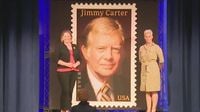On October 1, 2025, the Carter Center in Atlanta buzzed with a sense of history and emotion. What would have been former President Jimmy Carter’s 101st birthday became the stage for a unique tribute: the unveiling of a United States Postal Service Forever stamp honoring the 39th president. The event drew Carter family members, Postal Service officials, and admirers from across the nation, all gathered to remember a man whose legacy stretches far beyond the White House.
The stamp, now available at post offices and online, features a 1982 portrait of Carter painted by Herbert Abrams. It’s a dignified image—one that captures Carter’s steady gaze and quiet strength. With this release, Carter joins a select group of Americans to be immortalized on a USPS stamp, a distinction reserved for those whose impact on the country is indelible. According to the Atlanta Journal-Constitution, the ceremony was filled with both formality and warmth, as Carter’s family and friends reflected on his life and legacy.
“It is our hope that this stamp will serve as a reminder that one person, guided by principle and empowered by compassion, can indeed change the world,” said Thomas Marshall, executive vice president of the U.S. Postal Service, as reported by Healthbeat. The symbolism wasn’t lost on anyone present. For the Carter family, the stamp is more than just a piece of postage—it’s a symbol of enduring love, service, and commitment.
Beth Davis, chief operating officer of the Carter Center, echoed this sentiment. “The Postal Service played a central role in President Carter’s life,” Davis noted, explaining how Carter’s relationship with mail began in childhood. From postcards sent by an uncle that inspired him to join the Navy, to love letters exchanged with his wife Rosalynn while he was at the Naval Academy, the mail was a thread running through Carter’s story. Even as technology advanced, Carter remained loyal to traditional mail. “He did embrace modern technology, but he was clearly much more comfortable with the stamp,” Jason Carter, his grandson and chair of the Carter Center board of trustees, said with a smile.
Indeed, the day’s tributes went beyond the official. Local resident Happy Johnson shared her hopes of launching a letter-writing campaign using the new stamp. “We want the students to go back to the basics. To send the letters out, just flood the mailboxes,” Johnson said, according to Healthbeat. The sentiment reflects a broader desire to reconnect with the kind of personal, thoughtful communication that Carter valued.
But Carter’s legacy isn’t just about stamps, letters, or even his time in the Oval Office. It’s about a lifelong mission to serve others, a mission perhaps best symbolized by a curious object that sat on his desk at the Carter Center: a clear plastic jar containing a preserved Guinea worm. For Carter, this was no mere curiosity. It was a daily reminder of one of his most ambitious humanitarian goals—eradicating Guinea worm disease, a parasitic affliction that has tormented communities for centuries.
According to Healthbeat, Carter’s campaign against the Guinea worm began in earnest in 1986, when he and Rosalynn Carter brought their influence and the resources of the Carter Center to the fight. At that time, millions suffered from the disease annually. The Carter Center’s approach was innovative and empathetic: instead of imposing solutions, they worked hand-in-hand with local leaders and communities, learning from them and respecting their traditions. Adam Weiss, director of the center’s Guinea worm eradication program, explained, “You have to understand their context. You have to understand their beliefs, which may be different than your beliefs.”
The Guinea worm, or Dracunculus medinensis, is contracted by drinking contaminated water. The larvae mature inside the body, and after nearly a year, the female worm—sometimes up to three feet long—emerges painfully through the skin. The new documentary, The President and the Dragon, released on Carter’s birthday on Amazon, Hoopla, and Verizon Fios, doesn’t shy away from showing the suffering caused by the disease. Scenes of a young girl screaming as a worm is extracted from her ankle are hard to watch, but they drive home the urgency of Carter’s mission.
Progress has been nothing short of remarkable. As reported by Healthbeat and the Atlanta Journal-Constitution, the number of Guinea worm cases has plummeted from millions in 1986 to just four reported cases so far in 2025. This near-eradication is a testament to the Carter Center’s tireless work and the power of community-driven health interventions. A pivotal moment came in 1995, when Carter helped negotiate a six-month “Guinea worm ceasefire” in southern Sudan, allowing health workers to enter and provide not just Guinea worm treatment but also immunizations—an extraordinary example of diplomacy and compassion intersecting.
“One of the biggest lessons learned is meeting people where they are, which means you have to listen to them,” Weiss told Healthbeat. The Carter Center’s strategy included simple but effective solutions like water filtration systems and robust surveillance in endemic countries. The documentary, directed by Waleed Eltayeb and Ian Murphy, highlights these efforts and donates its proceeds to the Carter Center, furthering the fight against neglected diseases.
For Carter’s family, the stamp and the documentary serve as reminders of a legacy rooted in empathy and action. Jason Carter joked at the unveiling, “I think one of the greatest things about this stamp is that if you put it on your wedding invitation, it almost guarantees a 77-year marriage.” The laughter in the room was tinged with pride; Carter and Rosalynn’s partnership was legendary for its strength and longevity.
After the ceremony, guests lingered at the Carter Center, swapping stories and sharing memories. Some admired the oil portrait by Abrams, while others paused by the plastic jar with its silent, coiled Guinea worm—a symbol of the suffering Carter fought to end. The stamp, now traveling on letters across the country, is a small but powerful tribute to a man whose reach was global, but whose heart was always close to home.
In the end, the Forever stamp is more than a commemoration. It is a call to action—a reminder that ordinary people, armed with compassion and determination, can change the world. For Jimmy Carter, that mission continues, one letter, one life, and one victory at a time.






